|
|
 I picked up a few books yesterday afternoon at a store in Pacific Heights, in the midst of assembling my "Further Reading" list for The BLDGBLOG Book, and so I've got books on the brain. I thought I'd take a minute or two to stroll through my bookshelves and call out a few of the titles I happen to be reading right now or have recently finished. So yesterday I bought Coal: A Human History by Barbara Freese. Coal tells "the fascinating history of a simple black rock that has shaped our world – and now threatens it." Freese writes, and I quote at great length: To grasp the magnitude of coal's global impact, we must try to picture history without the momentous, high-intensity pulse of industrialization that started in Britain and then swept the world. The mainly agrarian world would have stayed in place for decades or centuries longer, with slower technological progress, less material wealth, and more gradual social change. Mass-production capitalism would not have soared to prominence, industrial working classes and places like nineteenth-century Manchester would not have mushroomed, and the Communist Manifesto would never have been written. The North might have lost the American Civil War, or it might never have started, and the transformation of the American West would have happened slowly by wagon rather than quickly by rail. The World Wars might never have exploded without the industrial rise of coal-rich Germany. Colonial conquests would have been far less sweeping, dramatically altering the history of all the societies that were dominated by foreign industrial powers, including China's (whose ancient history would have been altered as well). The labor and environmental movements, if they had existed at all, would have taken very different forms. In short, none of the defining and epic struggles of the nineteenth and twentieth centuries would have played out as they did. It's the intrusion of geology into human history – a kind of economic batholith – the interaction between a fragment of the earth's surface and the political development of the modern nation. I also picked up a copy of The Slave Ship: A Human History – note the identical subtitles – by Marcus Rediker. Here, Rediker looks at the "floating dungeons" of the world's earliest stab at transatlantic globalization: For more than three centuries, slave ships carried millions of kidnapped Africans across the Atlantic in a "wooden world" where crew and captives alike lived with the ever-present fear of shipwreck, epidemics, and hungry sharks. As a cruel instrument of war and commerce, the slave ship helped to shape the Western world. Yet until now, it has remained a mystery. Aside from being a social and economic history of the slave ship, the book also explores the ship's technical structure – the mobile architecture of confinement. I'll hopefully start reading them both soon. Books I'm currently in the process of reading, or have just finished, and that I'd recommend, include Kitty Hauser's Bloody Old Britain: O.G.S. Crawford and the Archaeology of Modern Life. Crawford was an aerial archaeologist in England in the early 20th century, his "new skills of interpreting the earth from above," discovering previously unknown landscape details, learned while flying reconnaissance missions during World War I. Crawford and his colleagues, Hauser writes, "thought prehistory should be approached not through texts (as many archaeologists preferred) not through fetishized 'finds' (like those collected and admired by antiquarians), but through the spatial logic of geography. It made sense to think about the distribution of particular kinds of objects or sites over geographical space, rather than looking at them in isolation." This was "a way of spatializing prehistory, restoring geographical connections and the materiality of the landscape to a subject that was too often reduced to disjointed objects or texts." After all, she adds, "It was not just where ancient sites were to be found that interested him; it was how they related to each other, what constellations they formed, and how the siting of those constellations related to topography – geology, vegetation, trade routes, sources of water."  [Images: O.G.S. Crawford and his aerially archaeological airplane; a view of the countryside from above, where remnants of history cast long shadows]. [Images: O.G.S. Crawford and his aerially archaeological airplane; a view of the countryside from above, where remnants of history cast long shadows].Though I haven't finished Hauser's book yet, I'm enjoying it immensely. Hauser also sent me an essay called "Revenants in the Landscape: The Discoveries of Aerial Photography," from her recent book Shadow Sites. On a casual skim here, that essay appears to deal with the trigonometry of shadows as seen from the air and what these shadows might indicate about unexplored – and abnormal – features in the English landscape. As she writes in Bloody Old Britain, "at certain times of day, when the sun is low in the sky, the outlines of ancient fields become visible over Salisbury Plain, as shadows throw their ridges and dimples into sharp relief; these are known as 'shadow sites'." Speaking of Stonehenge, a few months ago I read Stonehenge, author Rosemary Hill's excellent contribution to the Wonders of the World series edited by Mary Beard. While it might seem like the world can't possibly need another book about Stonehenge, Hill's approach is consistently interesting and deliberately written for a general audience. Throughout the book she describes the imaginative, political, artistic, and historiographic influence of the ancient monument, from William Blake's engravings and the architecture of Inigo Jones to the Led Zeppelinized druidry of the late twentieth-century. I read a British copy of the book, published by Profile, but Harvard University Press – whose publicity blog is worth a read – has their own version coming out this fall. For a monument of a different sort, we turn to Glen Canyon Dam. Just last week I finished reading James Lawrence Powell's forthcoming book Dead Pool: Lake Powell, Global Warming, and the Future of Water in the West. I'd say more about that book here, in fact, but I'm reviewing it for another publication and so I'll save my thoughts for that article. But it is an interesting book, if imperfect, and it presents some very large questions quite early on in the text. Powell writes: Why did our government dam nearly every river in the West, some a dozen times or more? Why were dams built even though the associated irrigation projects were obvious money-losers? Why, within a decade or two of the launching of the United States Reclamation Service in 1902, were every one of its founding principles betrayed? More evocatively, he asks: "What do we do when across the West are spread not beautiful blue-water lakes, but a hundred million acre-feet of mud, some of it laced with toxins? Where then will our successors get their water?"  [Images: The cover of, and spreads from, Ant Farm: Living Archive 7 by Felicity D. Scott]. [Images: The cover of, and spreads from, Ant Farm: Living Archive 7 by Felicity D. Scott].The idea of speculative futures for otherwise unanticipated monuments brings me to Felicity D. Scott's recent book Ant Farm: Living Archive 7, published by ACTAR. Scott's book is a graphically inspired but sluggishly written exploration of Ant Farm, a 1960s/70s American architectural avant-garde, whose projects included mobile educational facilities, "investigations into the psychedelic and environmental potentials of electronic technology," inflatable parachute-buildings and "moment villages" in the American desert, and a bewildering variety of other experimental structures, almost all of which, Scott adds, were "portable, 'instant,' temporary, cheap, and high-tech." It's Archigram-meets- NASCAR amidst inflatable polyethylene megastructures in the California desert – high on LSD and powered by cheap oil – prefiguring today's ongoing experiments in rogue instant-urbanism, like Burning Man. The book is beautifully designed and it includes an awe-inspiring 120-page Timeline of the group's output; these images alone – really only about two-thirds of the book's total eye candy – make it a rewarding and memorable resource. I've been reading a load of other books lately, from Reza Negarestani's future cult-classic Cyclonopedia to Robert MacFarlane's outstanding The Wild Places, but I hope to post more about those titles soon.
 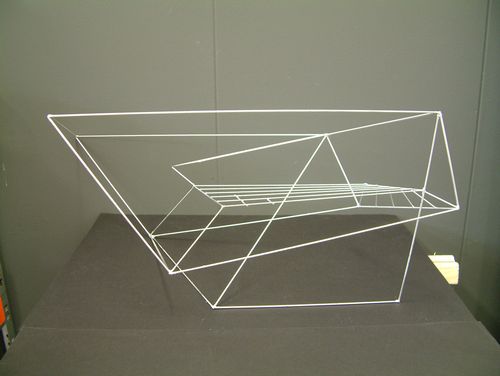 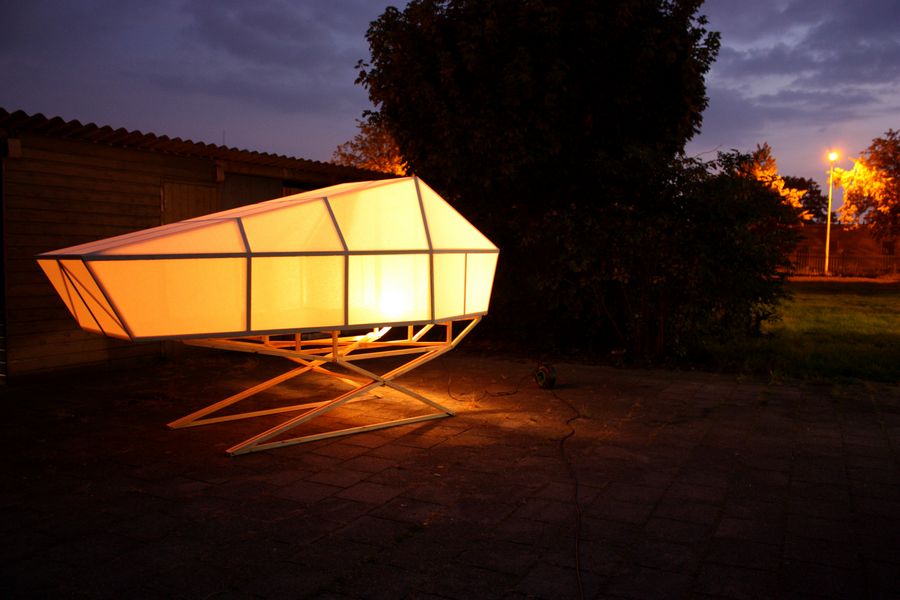  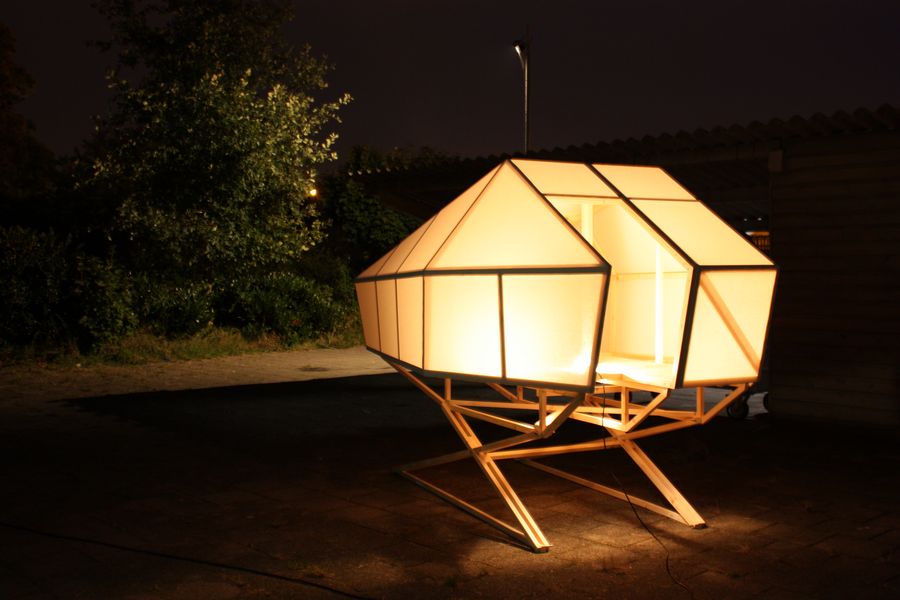  [Images: Object 02, including two interesting wire studies for the project, followed by a "light object," all by Jeroen Molenaar – who also took this amazing photograph. Object 02 is on display now at the Cultuurwerkplaats R10 in Zwolle, Netherlands. The structure seems to visually exemplify the idea that a work of architecture could double as a cantilevered lighting fixture installed on its site in the city. Or what if small, inhabitable lamps dotted the urban field? You climb into your lamp at night – and turn it off to sleep. Residents who have gone to bed form a dark constellation of unlit structures against the illuminated backdrop of those who've stayed awake; the city becomes a burning signage that graphs sleep]. [Images: Object 02, including two interesting wire studies for the project, followed by a "light object," all by Jeroen Molenaar – who also took this amazing photograph. Object 02 is on display now at the Cultuurwerkplaats R10 in Zwolle, Netherlands. The structure seems to visually exemplify the idea that a work of architecture could double as a cantilevered lighting fixture installed on its site in the city. Or what if small, inhabitable lamps dotted the urban field? You climb into your lamp at night – and turn it off to sleep. Residents who have gone to bed form a dark constellation of unlit structures against the illuminated backdrop of those who've stayed awake; the city becomes a burning signage that graphs sleep].
A new exhibition called Forest, curated by Cécile Martin, opens up tomorrow night in Montreal. For the show, "artists and architects have joined forces to propose a new vision of the forest." 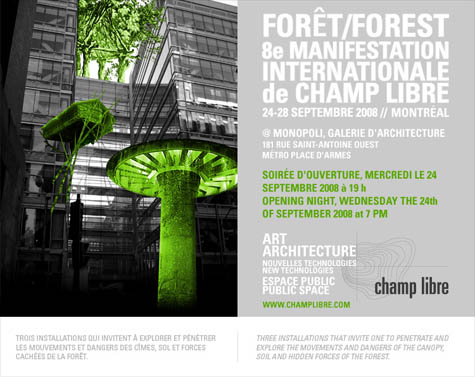 There are three pavilions in all: "three installations that invite one to penetrate and explore the movements and dangers of the canopy, soil and hidden dangers of the forest." They include the poetically named "From Chernobyl to Montreal, the Incandescent Zen Garden," whose creators note that "the natural phenomena of radioactivity and sound waves are amplified," with part of the installation "illuminated night and day by a red light, the same one that made the forest – the Red Forest – adjacent to the Chernobyl nuclear reactor vibrate." This slightly unclear image nonetheless leaves me wondering what the biological effects might be if you could cause a several-acre test-forest to vibrate constantly: what strange roots and branches would grow? Would constant vibration cause radically new tree structures to grow – or just make for some very happy plants? It'd be like the sound farm, only more tactile – and far stranger. A perpetual earthquake as a lab for cultivating the unnatural. The other two pavilions, meanwhile, are "The Macrocosm of Fiber or the Filtering Pavilion" and "The Mobile Branch, A Forest of Hypnosis and Vertigo." The latter project, a collaboration between architect Philip Beesley – whose work was explored here a few years ago – and artist Patrick Beaulieu, is described a kind of animatronic thicket: "A raised three-dimensional flooring and a cover propelled at 300 rotations per minute form a vibrating dance of branches and twigs, constituting a human-sized space of the in-between from which humans are nevertheless excluded." You wander into a forest – only to realize that it's not a forest at all, but a vast machine... There are a series of workshops on Friday and Saturday, as well – so if you're anywhere near Montreal, check it out! Tell them you heard about it on BLDGBLOG.
 The White House Redux competition – discussed earlier this summer on National Public Radio – will soon be a book: With almost 500 submissions from 42 countries around the world, White House Redux, a competition launched by Storefront for Art and Architecture and Control Group last January, became one of the most talked-about architecture competitions in 2008. The brief was simple: what would the residence of the most powerful individual in the world, the White House in Washington, D.C., look like if it were designed today?
Published to coincide with the opening of an exhibition of the competition's results at Storefront for Art and Architecture, White House Redux—The Book contains a compendium of documentation related to the competition and an overview of the results. It includes essays by Joseph Grima (Storefront for Art and Architecture) and Geoff Manaugh (BLDGBLOG and Dwell Magazine), a history of the existing White House and 123 selected projects as well as the four winning submissions. A jury assessed the submissions in the spectacular setting of the 45th floor of the World Trade Center Tower 7, a process documented in the book's 30-page photoessay by Marty Hyers.
The book is to be available for pre-order and will ship on October 2, 2008, to coincide with the prizegiving and opening of White House Redux at Storefront for Art and Architecture, New York. White House Redux was printed in a limited edition of 500 copies.
734 pages, color and black & white (7.8” x10.5”)
$39 USD Shipping: $5 (USA), $12 (Rest of the world)
Discounts available on shipping for multiple copies With a print-run of only 500, the book should go fast – so order a copy before they all disappear. (Note: This might be my last post here for a few days, as I'm going away for a quick – but much-needed – family vacation).
Apparently, "almost half" of the fluorescent light bulbs used in the Japanese module of the International Space Station have begun burning out far earlier than expected. An entire section of the station thus might soon be left in darkness.  [Image: Kibo, the Japanese module of the International Space Station, soon to be without internal light]. [Image: Kibo, the Japanese module of the International Space Station, soon to be without internal light].Although an impending delivery of new bulbs will undoubtedly bring light back to the failing module, the implication that astronauts aboard something like the International Space Station – or some special, trans-galaxial touring edition, launched twenty-five years from now – might be faced with total darkness, a darkness from which they cannot be rescued, is mind-boggling. At the very least it would make a great film: ten minutes into what you think is a science fiction adventure story, all the lights on the ship go out. There is no way to replace the bulbs. The next hour and a half you listen – after all, you can't watch – as a group of orbiting athletes and scientists slowly comes to grips with their situation. They are drifting out past the rings of Saturn inside a strange constellation of unlit rooms – and they will never have light in the station again. Five years from now one of them will still be alive, half-insane, speaking into a dead transmitter. The price of seeing stars is darkness, he whispers to himself over and over again, as his failing eyes gaze out upon nebulas and planets he'll never reach. (Via Wired Science).
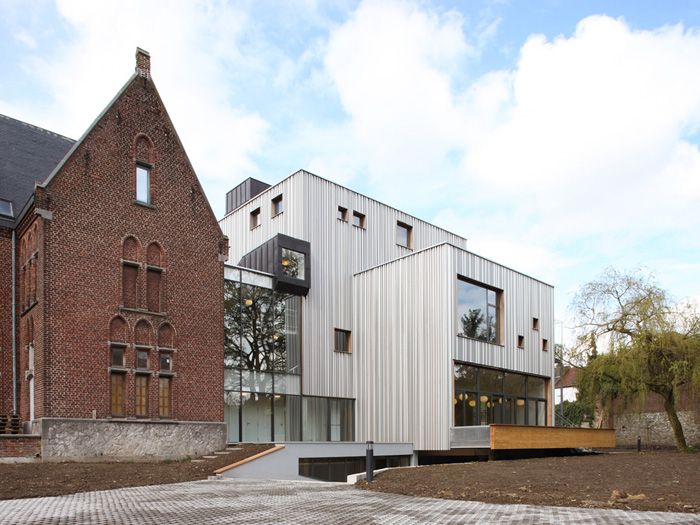 [Image: A new wing for the Museum of Photography in Charleroi by l'Escaut; photo by Filip Dujardin]. [Image: A new wing for the Museum of Photography in Charleroi by l'Escaut; photo by Filip Dujardin].Belgian architects and scenographers l'Escaut have completed a new wing for the Museum of Photography in Charleroi, Belgium. In an email received this morning, l'Escaut describes the project as being "situated at the intersection of architecture, landscape, city planning, photography and fine arts." This wide-ranging program, they go on to point out, "matches the interdisciplinarity of l'Escaut both in its daily life (l'Escaut is situated in a building shared with theatre actors and artists) as in its architecture practice (anthropology, landscaping, city planning, communication intervene in the projects)." They are not really architects, in other words; they practice something more like landscape anthropology. 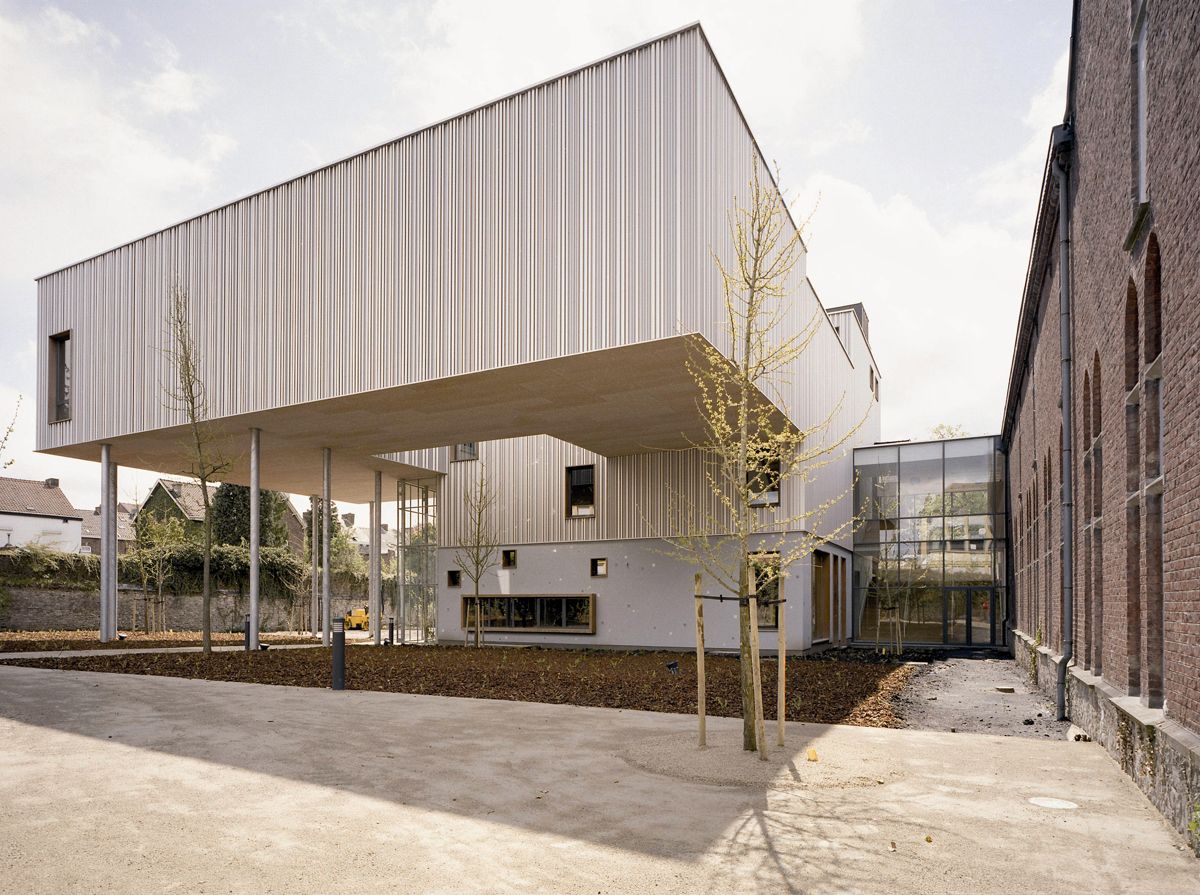 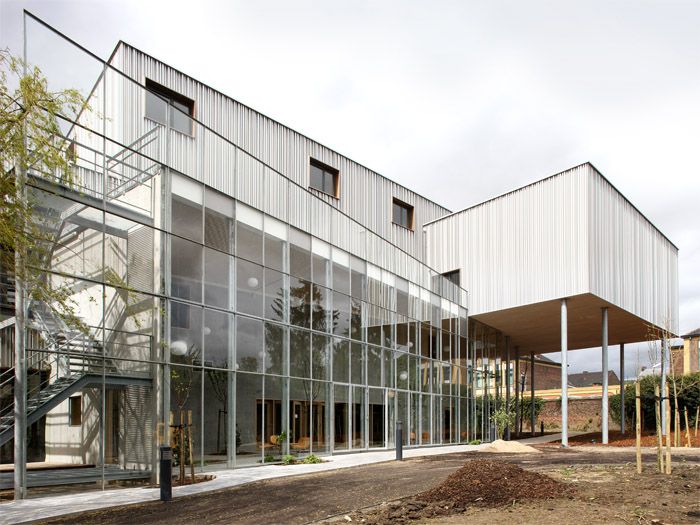 [Images: A new wing for the Museum of Photography in Charleroi by l'Escaut; photos by Filip Dujardin]. [Images: A new wing for the Museum of Photography in Charleroi by l'Escaut; photos by Filip Dujardin].L'Escaut's new wing is a surprising addition to the existing structure. Partly raised on stilts, partly cantilevered, and almost entirely defined by a very clean-lined modern geometry, the added galleries nonetheless include a brief glimpse of botanical free-will: a "winter garden" that "shelters fragrant plants inside the museum." Photosynthesis meets photography. 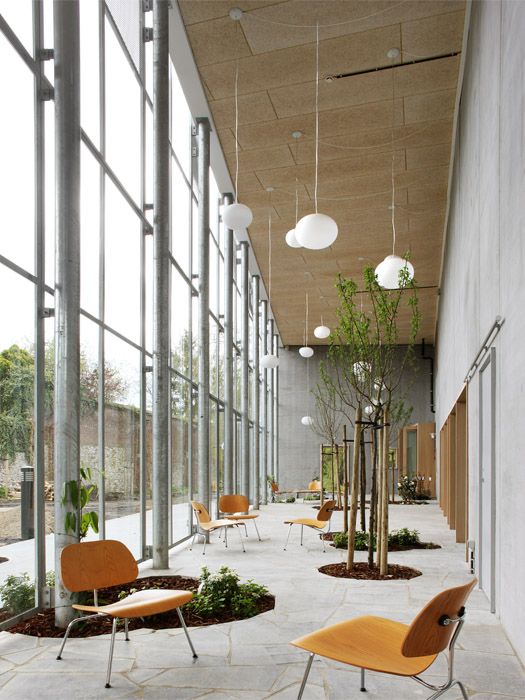 [Image: A new wing for the Museum of Photography in Charleroi by l'Escaut; photo by Filip Dujardin]. [Image: A new wing for the Museum of Photography in Charleroi by l'Escaut; photo by Filip Dujardin].The galleries themselves, we're told, are part of an overall "spatial scenography" of the site. Everything here is about views, counter-views, cross-views, and panoramas. Everything helps to frame everything else. The architecture itself is photographic, you could say: the rooms flow into each other through a succession of bare white walls and exposed concrete, as if the space has been edited. This raises the question, though, of the point at which space, actively experienced, becomes cinematic. Are buildings ever truly photographic, or are they more like short films? 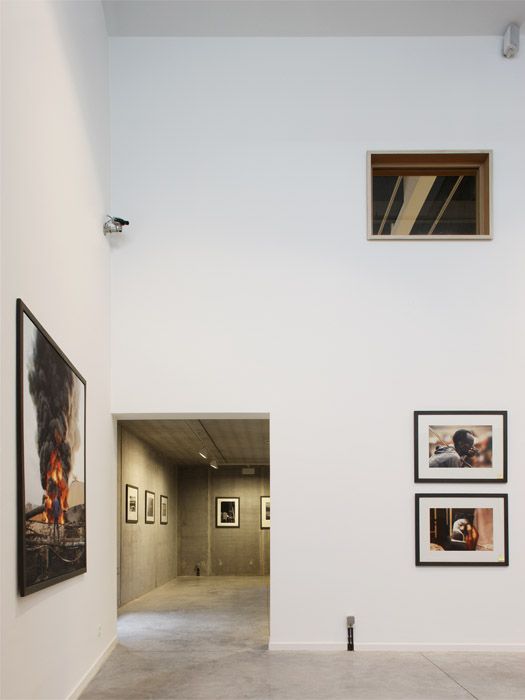 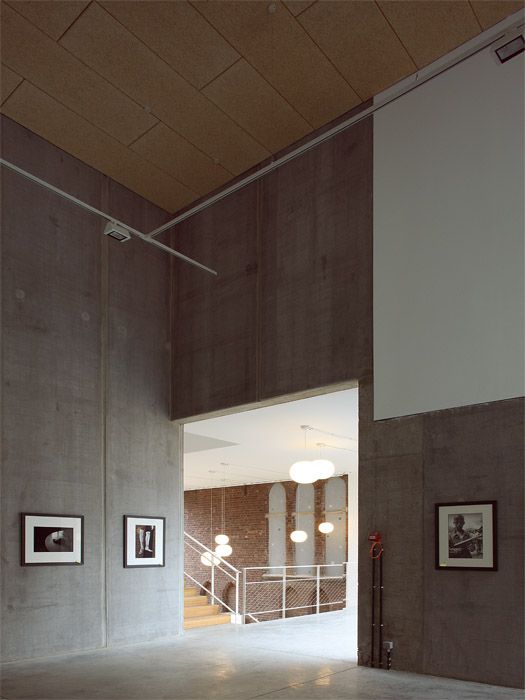 [Images: A new wing for the Museum of Photography in Charleroi by l'Escaut; photos by Filip Dujardin]. [Images: A new wing for the Museum of Photography in Charleroi by l'Escaut; photos by Filip Dujardin].In any case, the story behind the original building itself is fascinating: it turns out that the Museum of Photography is a former Carmelite convent. The grounds include what used to be the nuns' orchard. This entails all sorts of interesting theological problems, as we'll see. 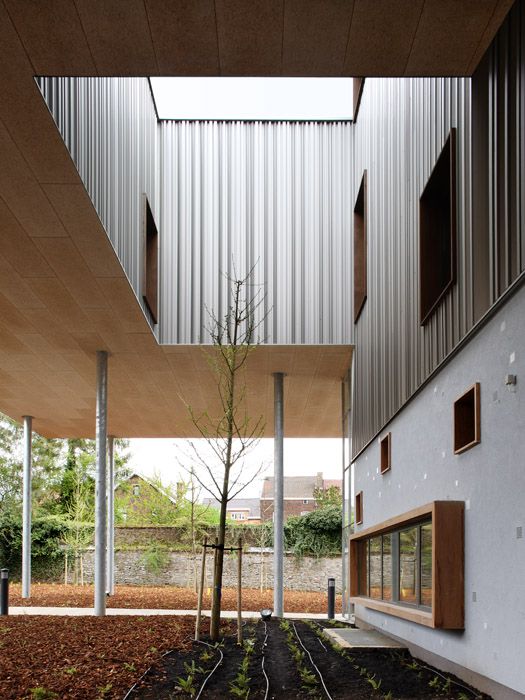 [Image: A new wing for the Museum of Photography in Charleroi by l'Escaut; photo by Filip Dujardin]. [Image: A new wing for the Museum of Photography in Charleroi by l'Escaut; photo by Filip Dujardin].Religious prohibitions against "graven images" become abstractly involved in the planning process: The transformation of the convent into a museum of photography was a reverse process of existing logics in the building. A place where looking at the world was forbidden because of religious reasons became a place of revelation of the image for societal reasons. Its extension defies conventional museum logics by multiplying the relationships to photography, its history and its many facets of representation. In other words, is a museum of photography – a temple of the graven image – a site for the "revelation of the image," as the architects write – an inherent violation of Christian doctrine? Is it de facto heresy to celebrate photography in a site formerly dedicated to the worship of god? These unresolved tensions help to animate the interlinked spaces of the museum itself. 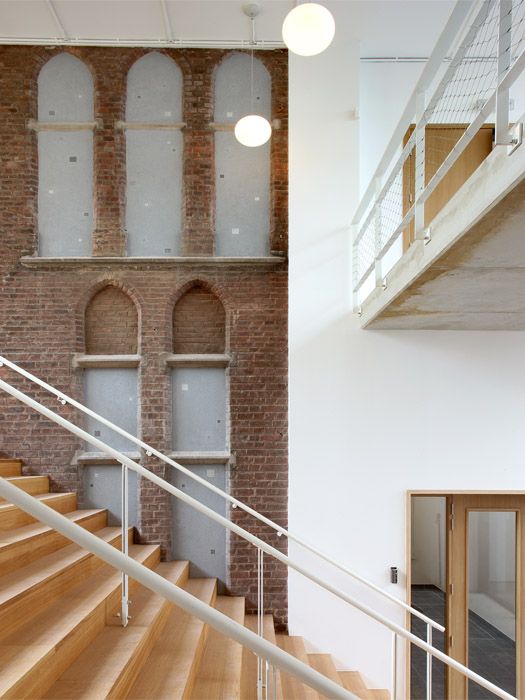 [Image: A new wing for the Museum of Photography in Charleroi by l'Escaut; photo by Filip Dujardin]. [Image: A new wing for the Museum of Photography in Charleroi by l'Escaut; photo by Filip Dujardin].Here are some photos of the construction process, More about the project, meanwhile, can be found here.
Something about the previous post reminded me of a project by Elliott Malkin called Graffiti For Butterflies.  [Images: Graffiti For Butterflies by Elliott Malkin].Graffiti For Butterflies [Images: Graffiti For Butterflies by Elliott Malkin].Graffiti For Butterflies attempts to "direct" monarch butterflies "along migratory routes in North America," using "images of milkweed flowers to broadcast the location of food sources." Malkin applies sunblock to these images in order "to optimize the graffiti for butterfly vision." He calls this Urban Interspecies Communication. Overlooking the most basic question here – of whether or not this would actually work – the very idea that we might deliberately construct an alternative visual system inside our cities, legible only to other species, is totally fascinating. What devices of route-finding and navigation could we purposefully produce for non-humans? Is there a burgeoning field of graphic design for other species? Post-human signage and symbology? There are already olfactory labyrinths left behind by dogs, for instance, and there are accidental but extraordinarily complex sense-trails following us everywhere – from food scraps to automobile exhaust to whiffs of perfume on the subway – but what deliberate "graffiti," otherwise undetectable by humans, could we create in order to help other species navigate the urban world? Using special UV paints to mark artificial migration routes across the continent seems like an amazing way to begin the investigation.
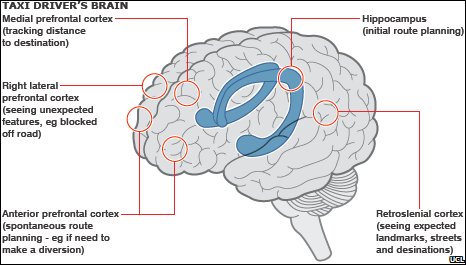 [Image: Route-finding and spatial perception in the brain; via the BBC]. [Image: Route-finding and spatial perception in the brain; via the BBC].Like something out of a short story by China Miéville, "scientists have uncovered evidence for an inbuilt 'sat-nav' system in the brains of London taxi drivers," the BBC reports. "They used magnetic scanners to explore the brain activity of taxi drivers as they navigated their way through a virtual simulation of London's streets. Different brain regions were activated as they considered route options, spotted familiar landmarks or thought about their customers." Taxi cab drivers' brains, we read, "even 'grow on the job' as they build up detailed information needed to find their way around London's labyrinth of streets – information famously referred to as 'The Knowledge'." It's interesting to note, meanwhile, that this appears to be an almost complete retread of news released more than eight years ago. There we learn not only that "the hippocampus is at the front of the brain," but that it "was examined in Magnetic Resonance Imaging (MRI) scans on 16 London cabbies." Cabbies' brains, that article reports, "'grow' on the job." However, it's also interesting to speculate here that "sat-nav" was not referred to by that earlier article because certain technologies – such as dashboard navigation and handheld GPS – simply had not yet reached an adequate price-point, or the required level of social acceptance, for "sat-nav" to be useful to that writer as a metaphor. If this were true, then perhaps you could track the infiltration of GPS and sat-nav technologies into the fabric of everyday life by the speed with which they have become recognizable as urban-spatial metaphors. (Via Boing Boing and Geoffrey S. George).
I just discovered Floater Magazine, "an inventory for floatation mechanisms within architecture," published and edited out of Athens, Greece. 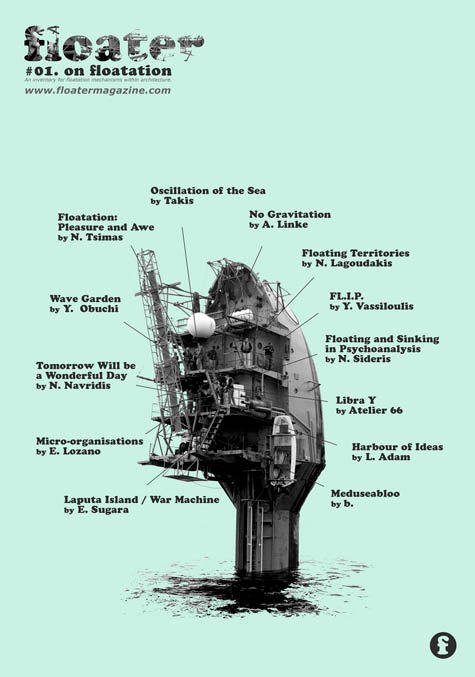 [Image: The cover of Floater Magazine #01; view larger]. [Image: The cover of Floater Magazine #01; view larger].The first issue includes articles about Laputa Island, OMA's Riga Port City development, floating territories, and an artistic device called the " Oscillation of the Sea," among many others, including the magazine's inaugural editorial statement. The design of the website itself – with mobile images you can rearrange according to taste – can be quite cool, as in this featurette about the micronational principality of Sealand. Better yet, all the articles can be downloaded as PDFs – so you can read them on the go.
 [Image: Le Corbusier's Maison Citrohan undergoes speculative regulatory alterations, as applied by Finn Williams and David Knight]. [Image: Le Corbusier's Maison Citrohan undergoes speculative regulatory alterations, as applied by Finn Williams and David Knight].An interesting architectural exhibition, put togther by Finn Williams and David Knight, closed today in London. Called The Rule of Regulations, it looked at what effect today's building codes and zoning regulations might have if retroactively applied to an historic structure such as Le Corbusier's Maison Citrohan. As the Architect's Journal described the show's more wide-ranging spatial implications, "perhaps we can seek out creative opportunities within the current legislative framework, maybe to arrive in a wonderland where new forms of architecture emerge." In The Rule of Regulations, Williams and Knight pit architectural conceits – here Le Corbusier's five points of Modern architecture – against five pieces of current housing legislation. They have remodeled Corb's early mass-housing prototype, the single-family dwelling Maison Citrohan (1922), to see how it might look in today's climate of environmental paranoia, lowest cost, equal opportunities and accessibility. The phrase "environmental paranoia" seems unnecessarily dismissive of very realistic – and reasonable – energy-performance criteria for the construction, maintenance, and use of buildings in the 21st century, but this excerpt still offers us a glimpse of what was at stake in the exhibition's premise. 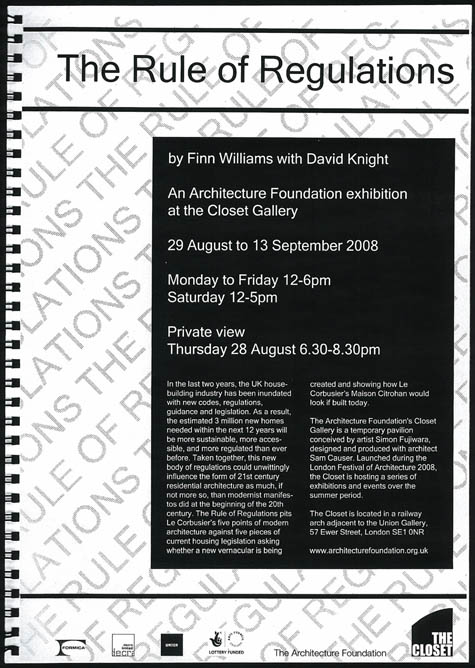 [Image: View larger]. [Image: View larger].And the premise was brilliant. Architectural practice is so thoroughly shaped from the outside-in by building codes, something which perhaps only becomes obvious when different historical periods are forced to collide. Semi-absurd thought experiments might ensue: What would the Taj Mahal, or Angkor Wat, look like if subjected to Manhattan's 1916 Zoning Law, as so thoroughly explored by Rem Koolhaas? Or how might the city of London be different if subject, overnight and without warning, to the urban regulations of Los Angeles, Dubai, or Beijing? Perhaps cities could even set aside small test-plots, urban labs in which gardens of architectural form can grow. 10 square blocks of west Los Angeles are re-zoned as if they're part of Paris; when new laws are passed in Paris, they go into force there, too. What new buildings and lifestyles might result? Sections of the city could take on the characteristic of a skin-graft. Suddenly three streets in downtown Chicago adopt the building codes of Amsterdam. You fly there on a business trip one summer when you realize that something just isn't quite right with the layout of a certain building... Perhaps you could even assign building regulations from different cities to specific rooms in a single Manhattan high-rise; there's a London room, a New York room, a Moscow room. The whole thing a test structure or legal demonstration project. Architects and architectural students alike come through for tours of the rooms to see what effects, both large and small, a simple change in the rules can generate.  [Image: View larger]. [Image: View larger].But if architectural interiors and exteriors alike are shaped by the spatial expectations of certain historically specific legal regimes, to what extent are the familiar landscapes and experiences of everyday life shaped off-stage, in the planning books and lunchtime meetings of urban planning boards? When we look back at what made certain cities thrive in different phases of modern history, are we wrong to cite artistic movements and architectural schools – when we should be crediting their planning departments? In any case, Williams and Knight raise a series of interesting questions about the relationship between architectural style and architectural regulation, and the historical tensions that exist within that partnership. I suppose one fundamental question here might be: Do architects need less regulation in order to pursue the art of spatial design – or simply more creative rules? Indeed, is it really possible to study Le Corbusier without also studying the legal codes within and around which he was forced to design? I'm reminded of Michael Sorkin's book Local Code, in which an entire city is described and presented – without the use of a single image – through the droll recitation of absurdly specific building regulations. How do invisible legislative skeletons shape modern space?
 [Image: New flats, part of the AHMM master plan in Barking, England, specifically cited by the BBC as being so small that they're mere slums in the making; via Building Design]. [Image: New flats, part of the AHMM master plan in Barking, England, specifically cited by the BBC as being so small that they're mere slums in the making; via Building Design]."Are the gleaming new apartment buildings of the past decade the inner-city slums of tomorrow?" the BBC asks this morning in an interesting, if insufficiently argued, opinion piece about the state of private housing in England. New, privately developed apartment complexes there – the exact same apartment complexes of visual interest to architecture magazines such as the one for which I work – might, in the end, simply be too small and too cramped to become anything other than the slums of tomorrow. Affordable now, ghettoized later. The problem, the essay argues, is that there are no real minimum space standards for private housing developments in England. Tiny flats suitable only for single men and women, or for weekend getaways, are filling up valuable land in city centers – which is great for the duration of a real estate boom, but which might have sociologically frightening future implications. "Alone in the UK," the BBC points out, "Scotland does have legislation on minimum sizes for homes in the commercial sector. Northern Ireland has rules on social housing – while in England and Wales many local authorities also have size regulations for affordable housing. But none of this covers private sector developments." One point, by no means minor, that goes totally unexplored comes from the BBC's own table of apartment space data. There we see that the average apartment size in Italy is actually smaller than the average apartment size in England. So why all the scare talk about future slums and ghettos? Is there a legitimate concern here that smaller living spaces might become crime-infested labyrinths when the economy dries up – or is this simply fear of other forms of social organization? Nuclear families living in several comfortable rooms = good. Single men and women living alone in small apartments = moral hazard. In any case, I thought suburbs were the next slums? In fact, it'd be interesting to do a kind of comparative slum futurology: to see what building types different countries and cultures fear will become the "next slum." What does it say about you, politically? On the left, perhaps, you think it's the suburbs, waiting to be taken over by wildcats and gangs; on the right, you think it's affordable housing. But who's got the data on their side?
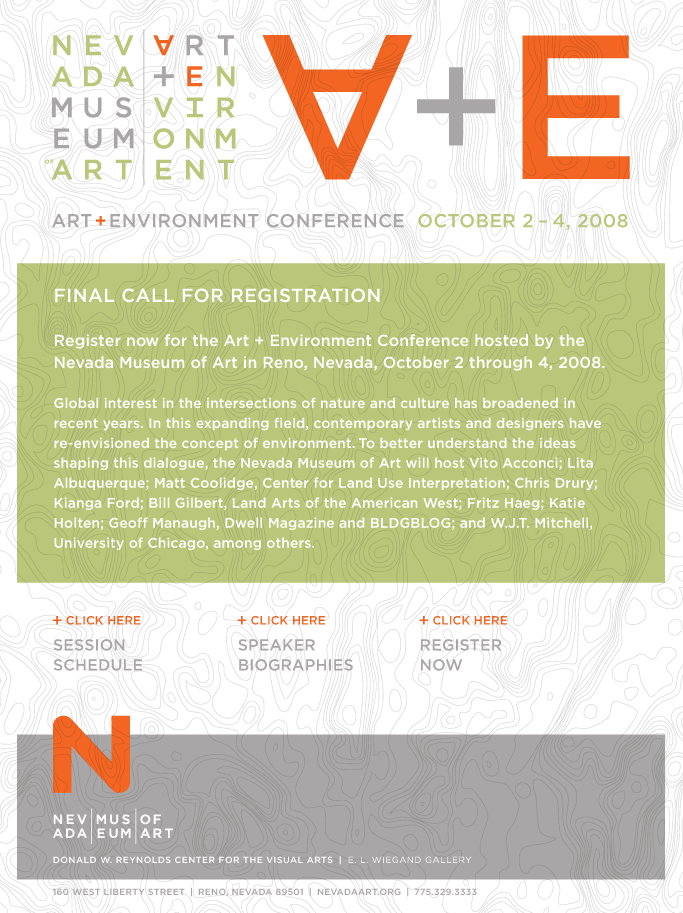 I'm excited to announce that I'll be speaking on a panel at the upcoming Art + Environment Conference hosted by the Nevada Museum of Art in Reno, from October 2-4. Other speakers include Matthew Coolidge of the Center for Land Use Interpretation, artist and architect Vito Acconci, photographer Michael Light, artists Fritz Haeg and Katie Holten, Bill Gilbert from Land Arts of the American West, and cultural organizer Cheryl Haines, among many others. The entire thing is being moderated by William L. Fox, a prolific writer, poet, and friend who often documents his own travels through extreme natural environments, describing those landscapes' effects upon human cognition. Here is a PDF with all the information you'll need to register for the conference; for more info about the speakers themselves, and their conference schedules, check out the conference website. 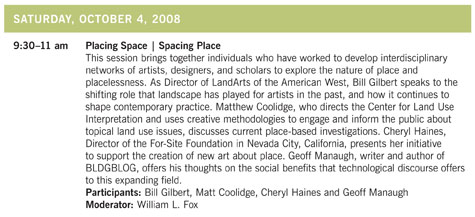 [Image: Panel description; view larger]. [Image: Panel description; view larger].My own panel, "Placing Space," will be on Saturday, October 4, at 9:30am. Hopefully I'll see a few of you there! I hope to come back not only with several new posts, but possibly with some interviews. Stop by if you get a chance.
Perhaps in the spirit of the Wonders of the World, the nuclear reactor in Hanford, Washington, has been declared a national historic site. "National Historic Landmarks," the Department of Energy explains, "can be nationally significant districts, sites, buildings, structures, and/or objects that possess exceptional value or quality in illustrating or interpreting the heritage of the United States." In a late-August news release ( PDF) we read: U.S. Department of the Interior (DOI) Deputy Secretary Lynn Scarlett and U.S. Department of Energy (DOE) Acting Deputy Secretary Jeffrey F. Kupfer today announced the designation of DOE’s B Reactor as a National Historic Landmark and unveiled DOE’s plan for a new public access program to enable American citizens to visit B Reactor during the 2009 tourist season. The B Reactor at DOE’s Hanford Site in southeast Washington State was the world’s first industrial-scale nuclear reactor and produced plutonium for the atomic weapon that was dropped on Nagasaki, Japan to end World War II (WWII). As the New York Times pointed out yesterday, however, Hanford is but "one of five Manhattan Project facilities designated as historic landmarks, including the Los Alamos Scientific Laboratory in New Mexico and the X-10 Graphite Reactor at Oak Ridge, Tenn." Another site is the so-called Chicago Pile. The atomic infrastructure of mid-century American warfare is thus slowly being converted into a distributed landscape of historic monuments. Perhaps it's dark tourism with a physics bent – the national memory of nuclear fission, a geography of Cold War nostalgia. They are places where the atom opened up – a series of small entryways into matter.
Google has filed a patent for what the New York Times describes as "mobile data center platforms out at sea." 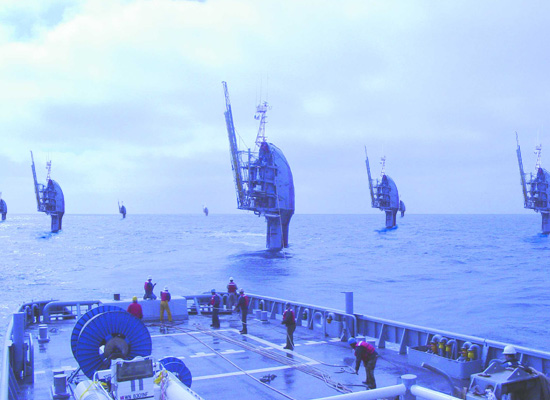 [Image: A view of the R/P FLIP ship, which has absolutely nothing to do with Google's offshore server plan; it just looks cool and seems appropriate. Image altered by Alexander Trevi]. [Image: A view of the R/P FLIP ship, which has absolutely nothing to do with Google's offshore server plan; it just looks cool and seems appropriate. Image altered by Alexander Trevi].This means "stacking containers filled with servers, storage systems and networking gear on barges or other platforms." These would be "'crane-removable' data center modules on ships." From the actual patent application: In general, computing centers are located on a ship or ships, which are then anchored in a water body from which energy from natural motion of the water may be captured, and turned into electricity and/or pumping power for cooling pumps to carry heat away from computers in the data center. Perhaps unsurprisingly in this era of alternative energy sources, "Google has theorized about powering these ocean data centers with energy gained just from water splashing against the side of the barges."  [Image: From Google's patent application for servers at sea; via the New York Times]. [Image: From Google's patent application for servers at sea; via the New York Times].I have to assume, then, that we're moving ever closer to true deep-water city-states – only they won't be libertarian ocean-going homesteads, after all, they'll be distributed networks of supercomputing villages afloat on, and drawing power from, the tides. Two weeks ago, meanwhile, the NYTimes also looked at the privatization of civic infrastructure – but perhaps Google's literally offshore experiment in information technology implies a coming world of privatized services at sea. A fleet of tankers shows up in a nearby port one day... and suddenly your city has telephone services. It's Archigram's instant city all over again, but on the level of specific – and highly billable – urban amenities. The services show up. The network takes over. Your city will never be the same.  [Image: The Instant City at work; diagrams by Peter Cook/Archigram. An original interview with Peter Cook appears in the forthcoming BLDGBLOG Book]. [Image: The Instant City at work; diagrams by Peter Cook/Archigram. An original interview with Peter Cook appears in the forthcoming BLDGBLOG Book].I'm further reminded of the five-week-long power outage that struck Auckland, New Zealand, just slightly more than ten years ago. Peter Gutmann describes some of the possible ship-borne solutions to that city's loss of electricity: Apparently the idea of moving ships from the naval base on the other side of the harbour across to the Auckland waterfront to act as floating generators was considered, but there are problems with feeding the power from the ships to the city. There's also the problem that there's nothing around which can generate even a fraction of the power required. Another idea which was considered is using one of the Cook Straight ferries (which could in theory provide around 10MW) as a floating generator (the term "ferry" is a considerable understatement). Currently a couple of waterfront businesses are being run with power from ships acting as floating generators, and when both repaired cables failed their testing, Mercury finally brought in a diesel-electric trans-Tasman freighter, the Union Rotorua, to act as a 12MW floating generator, and is considering bringing in another ship or installing generators on barges. In any case, the seafaring future of civic infrastructure is something we'll have to keep our eyes on. Entire new untold types of urban experience could be yours the minute that strange shape on the horizon comes in to dock. (Thanks, Nicky!)
Wildcats are taking over the foreclosed homes of Southern California. According to the neighbor of an abandoned house near Lake Elsinore, "this is the first she has heard of a wild animal taking over a foreclosure."  [Image: Karen Brown/The Press-Enterprise]. [Image: Karen Brown/The Press-Enterprise].So is the wild coming back for good – or has the ongoing U.S. real estate bubble simply produced temporarily ideal conditions for the return of bobcats and other large feline predators? After all, what sort of burgeoning ecosystem does the world of foreclosed homes represent? Mold, lichen, and vines; bears, deer, and wildcats. Repurposed McMansions, emptied of their human inhabitants, are filled in later by a troupe of mountain lions. I sense a children's film here. But is this really the way the wild will reclaim our world? Starting with foreclosed homes and moving inward, to the centers of cities, from there. Soon ivy crawls across the well-polished tables of New York boardrooms, as the suburbs fall prey to nests of field mice.
|
|
 I picked up a few books yesterday afternoon at a store in Pacific Heights, in the midst of assembling my "Further Reading" list for The BLDGBLOG Book, and so I've got books on the brain. I thought I'd take a minute or two to stroll through my bookshelves and call out a few of the titles I happen to be reading right now or have recently finished.
I picked up a few books yesterday afternoon at a store in Pacific Heights, in the midst of assembling my "Further Reading" list for The BLDGBLOG Book, and so I've got books on the brain. I thought I'd take a minute or two to stroll through my bookshelves and call out a few of the titles I happen to be reading right now or have recently finished.  [Images: O.G.S. Crawford and his aerially archaeological airplane; a view of the countryside from above, where remnants of history cast long shadows].
[Images: O.G.S. Crawford and his aerially archaeological airplane; a view of the countryside from above, where remnants of history cast long shadows]. [Images: The cover of, and spreads from, Ant Farm: Living Archive 7 by Felicity D. Scott].
[Images: The cover of, and spreads from, Ant Farm: Living Archive 7 by Felicity D. Scott].





 [Images: Object 02, including two interesting
[Images: Object 02, including two interesting  The
The 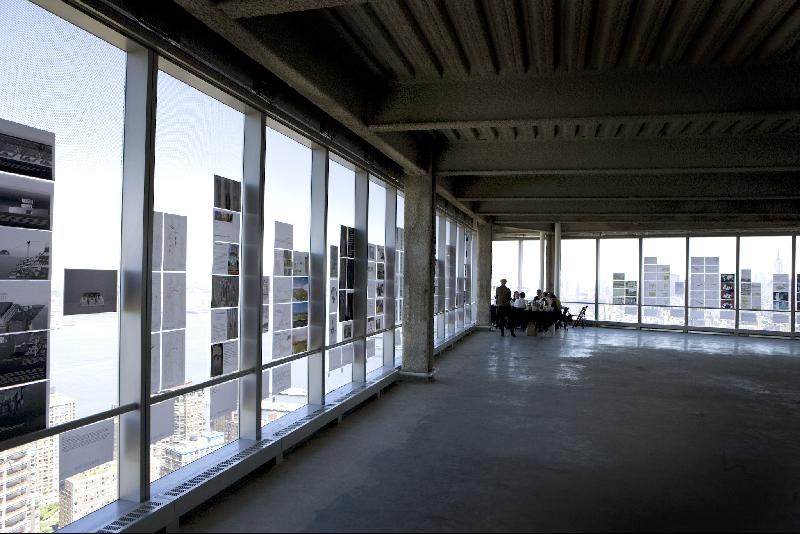 [Image: The
[Image: The  There are
There are  The
The  [Image:
[Image:  [Image: A new wing for the Museum of Photography in Charleroi by
[Image: A new wing for the Museum of Photography in Charleroi by 
 [Images: A new wing for the Museum of Photography in Charleroi by
[Images: A new wing for the Museum of Photography in Charleroi by  [Image: A new wing for the Museum of Photography in Charleroi by
[Image: A new wing for the Museum of Photography in Charleroi by 
 [Images: A new wing for the Museum of Photography in Charleroi by
[Images: A new wing for the Museum of Photography in Charleroi by  [Image: A new wing for the Museum of Photography in Charleroi by
[Image: A new wing for the Museum of Photography in Charleroi by  [Image: A new wing for the Museum of Photography in Charleroi by
[Image: A new wing for the Museum of Photography in Charleroi by  [Images:
[Images:  [Image: Route-finding and spatial perception in the brain; via the
[Image: Route-finding and spatial perception in the brain; via the  [Image: The cover of
[Image: The cover of  [Image: Le Corbusier's Maison Citrohan undergoes speculative regulatory alterations, as applied by Finn Williams and David Knight].
[Image: Le Corbusier's Maison Citrohan undergoes speculative regulatory alterations, as applied by Finn Williams and David Knight]. [Image: View
[Image: View  [Image: View
[Image: View  [Image: New flats, part of the AHMM master plan in Barking, England, specifically cited by the BBC as being so small that they're mere slums in the making; via
[Image: New flats, part of the AHMM master plan in Barking, England, specifically cited by the BBC as being so small that they're mere slums in the making; via  I'm excited to announce that I'll be speaking on a panel at the upcoming
I'm excited to announce that I'll be speaking on a panel at the upcoming  [Image: Panel description; view
[Image: Panel description; view  [Image: A view of the
[Image: A view of the  [Image: From Google's patent application for servers at sea; via the
[Image: From Google's patent application for servers at sea; via the  [Image: The Instant City at work; diagrams by
[Image: The Instant City at work; diagrams by  [Image: Karen Brown/
[Image: Karen Brown/


